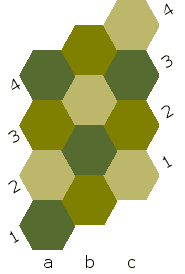Comments/Ratings for a Single Item
I had considered a hexagonal Jetan. The Flier would have a footprint that spanned a six-cell-sided hexagonal area. Thus the field might need to be twelve-cell-sided to accommodate this piece. If you maintained the original number of pieces(with only an extra Padwar and Flier to cover the extra diagonal pattern of the hexagonal field), this would leave a very large open area on this field. The opening portion of the game could be tedious.
The rules state: “Soldiers move one space straight forward until crossing the River, when they gain the ability to move one space obliquely orthogonally forward.” In Xiang Qi, Pawns on the last rank can still move left or right when they can no longer move forward. By the rule stated here, Pawns (Soldiers) in Snowflake Xiang Qi can move to places where they can no longer reach the opponent's palace. This strikes me as a flaw in the game. Even by the rules of Pawn movement in Xiang Hex, there are positions on the board from which a Pawn would be unable to reach the opponent's palace.
Have you considered that with this particular field's shape that the Soldiers may be forced into positions of ineffectiveness. The back rank of this field radiates away from the 'palace', allowing the potential of the Soldiers moving beyond the 'palace' and unable to return. Of course, this is only a small 'problem'. This could be corrected by moving the rank forward, either level or higher than the 'palace'. But then you risk bringing the Chariots into a position where they will have quick access to the field. But this could be handled by placing them in a position where there would need to be the development of at least one or two pieces before they could be brought out. Oh, wait, that's what I did in Xiang Hex. By your own admission, you have not thoroughly play-tested this game. So any claims of superiority are spurious. May I suggest that next time you wish to brag about your creation that you resist the urge to denigrate someone else's.
One reason for increasing the hexagonal field size by 50% is to increase the potential of the diagonal sliders. But XiangQi only has two particular diagonal movers, and they are restricted to one side of the field, and one type to a specific area. Thus increasing the size of the field does not actually gain any significant advantage for these pieces. It could be argued that the Horse uses a diagonal in its move. But this is simple a step. Increasing the size of the field will actually reduce its effectiveness. So the only reason to do so would be to slow its opening advance across the field. But looking at your attempt at a hexagonal XiangQi, I can see several un-necessary elements. That is the right and left section which make up the star pattern of the field. This would eliminate the extra Soldiers. Also the right and left cells from the 'Palace' could be eliminated. The game could actually work well without them, but this would destroy your overall theme.
The overall space in Xiang Hex is smaller. So, having a smaller Palace is in itself not a 'problem'. I believe that you are basing your judgement, not on an objective evaluation of the game, but on a mere subjective view. The dynamics of the hexagonal field are very different from the square field. To expect the same results is not realistic. The only way there could be a problem would be that it results in some form of triviality or weakness that allows one opponent to exploit to advantage. If both players have the same restriction it is merely a particularity of the game, not a problem. The honest thing you could say is that this particular game allows the players more room. In fact, more than the XiangQi field. It does not address any particular 'problem' with another game.
Did you miss that?
Exactly what is 'the Palace problem' of Xiang Hex? Just curious.
It can handle larger boards. You just need to know what to do. Your board will need to be cut out of a parallelogram shaped area of hexagonal spaces. Since the hexagons for this board are vertical, this area will consist of files that each begin half a space above the file to its left, like this:

Besides the Code and Board fields I mentioned to you before, you also need to change the value of the Columns field. This tells Game Courier how many columns wide your board will be. Since you're working with vertical hexagons, which naturally align into columns, instead of horizontal hexagons, which naturally align into rows, counting the number of columns needed by your board area is straightforward. Just count the number of vertical files on your board. This is 19.
One thing that makes this board tricky to do is that it is an unusual shape that doesn't include the corners of the area it must be carved out of as part of the board. You might start with a value for Code that includes your board area, then with that in view, you can begin to figure out what to remove. Another idea is to put your graphic image back in your paint program, place hexagons of another color all around it until you have a parallelogram shaped area of hexagons. This will then serve as a guide to what size area you need Game Courier to make and what cells you need to cut out of it to form your board.
 Joe Joyce wrote on Thu, Dec 4, 2008 02:41 AM UTC:
Joe Joyce wrote on Thu, Dec 4, 2008 02:41 AM UTC:
21 comments displayed
Permalink to the exact comments currently displayed.
